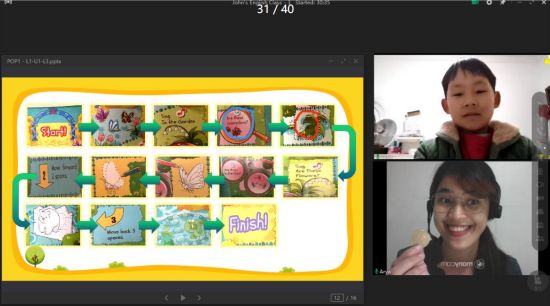It’s common for English language learners to struggle. Students may struggle for a variety of reasons – lack of confidence, learning style, and time constraints to name a few. The good news is that there are ways to help struggling English language learners overcome these challenges. Let’s explore some systems and strategies you can employ in your classroom, whether teaching in person or online, to help struggling English language learners be successful.
New to TEFL? Learn about getting qualified with Bridge to teach online or in person around the world, and explore our online TEFL certification courses.
1. Use visual aids and realia
Using visual aids and realia, or real-life objects, can significantly enhance learning for struggling English language learners by providing concrete, contextualized references that support comprehension. Visual aids such as pictures, charts, and diagrams help English language learners grasp new vocabulary and concepts by linking abstract ideas to familiar, tangible images.
Using realia in the ESL classroom further reinforces understanding by allowing students to physically interact with props related to the lesson, making learning more engaging and memorable. Using props can help bridge the gap between students’ language abilities and the content, promoting deeper understanding and retention of material.
2. Embrace multisensory learning
Embracing multisensory learning – engaging sight, sound, touch, and movement – can greatly benefit struggling English language learners by activating different parts of the brain, enhancing both comprehension and retention. Helpful for all age levels, multisensory learning is particularly effective for young learners. By using various senses to process information, students are better able to make connections between new vocabulary and concepts. For instance, combining visual cues, auditory instructions, physical activities, and tactile experiences can help solidify understanding, making abstract ideas more accessible. This holistic approach caters to diverse learning styles and reinforces language development, allowing students to grasp content in more meaningful and personalized ways.
3. Provide regular feedback and encouragement
Providing regular feedback and encouragement is essential for supporting struggling English language learners, as it helps build their confidence, motivation, and understanding of their progress. Positive reinforcement and encouragement can reduce the anxiety that many English language learners experience, making them more willing to participate and take risks in learning. Encouragement may simply be enthusiastic feedback written on assignments or spoken during class or may come in the form of simple reward systems.
Help struggling English language learners by employing effective feedback strategies that take into account timing, balance positive and constructive commentary, and vary in format. When students feel supported and valued, they are more likely to stay engaged and motivated. Students who are engaged and motivated often progress in their language goals more quickly and enjoy more overall academic success.
Read about 10 sure-fire ways to inspire and motivate your ESL students.

4. Differentiate instruction based on individual needs
Differentiating instruction based on individual needs is crucial for helping struggling English language learners succeed, as it allows educators to tailor lessons to each student’s language proficiency, learning style, and academic background. By providing personalized support, such as modified assignments or alternative ways to demonstrate understanding, you can ensure your English students engage with the content at their own level.
This strategy is particularly useful when English students are working on a niche area. For example, teachers can hyper-personalize a Business English lesson to empower a student to access the curriculum more effectively, boosting confidence and academic achievement.
5. Integrate technology and digital tools
Integrating technology and digital tools can greatly enhance learning for English language learners by providing interactive resources that support language development. Whether you teach in person or online, integrating technology into your instruction can engage and motivate students and help bridge learning gaps. For example, teaching vocabulary or grammar concepts using online game platforms like Kahoot! and Bamboozle can make learning fun and expose students to new ways of visualizing the concepts, and online visuals can help make content more accessible.
Technology is revolutionizing English language teaching in many ways. Using AI and other smart tech advances, you can create interactive formative assessments, access authentic writing and spoken English materials, and much more. By leveraging technology, teachers can create a more inclusive and supportive learning environment that meets the diverse needs of English language learners.
Read about creating engaging multimedia content for Business English learners.
6. Focus on building vocabulary
Focusing on building vocabulary is important for English language learners because it lays the foundation for all aspects of language acquisition, including reading, writing, speaking, and listening. A strong vocabulary enables students to better understand classroom instructions, academic content, and everyday conversations, which in turn improves their overall communication skills. It also gives them the tools they need to decode new words and improve their reading comprehension, making it a critical component of their language development and academic success.
The last thing struggling students need is a huge list of vocabulary words to memorize, so teach ESL vocabulary using games and activities that will engage students. Play vocabulary hangman, sing ESL songs, play vocabulary charades, and more. As students engage with the vocabulary words in an interactive way, they’ll better acquire and retain the new words.
Looking for more game ideas? Explore our Micro-credential courses: Games and Activities for the Online Classroom for Very Young Learners, Young Learners, Teenagers, and Adults.
7. Create a positive and inclusive learning environment
Creating a positive and inclusive learning environment helps foster good relationships between you and your students. A sense of belonging and security is essential for academic and social development. When English language learners feel valued, respected, and comfortable, they are more likely to take risks when using their new language skills, participate in classroom activities, and engage with their peers. By promoting a supportive and welcoming atmosphere, teachers can help students thrive both linguistically and in academic settings.
Some ways you can create a positive and inclusive learning environment include incorporating fun icebreakers and other activities and getting to know your learners so you can tie lessons and resources to your students’ interests and needs. Activities like 20 questions can break the ice and help you get to know your students right from the start.

8. Simplify language and instructions
It’s important to keep directions simple and direct to avoid confusion. Simplifying the language you use when teaching and in your assignment instructions will help your students better understand and engage with class content.
By using clear, concise, and straightforward language, you’ll reduce the cognitive load on struggling students. This allows them to focus more on the key concepts rather than struggling with complex sentence structures or unfamiliar vocabulary. For example, breaking instructions into smaller, more manageable steps and avoiding idiomatic expressions are two ways to simplify your language and instructions.
9. Encourage peer learning and collaboration
Encouraging peer learning and collaboration is highly beneficial for English language learners, as it provides them with opportunities to practice language skills in a supportive, real-world context. Working with peers allows English language learners to hear authentic language use, ask questions, and receive feedback in a less formal setting.
Collaborative learning strategies, such as group projects or partner work, foster social interaction and build communication skills, while also promoting a sense of belonging. Peer learning also offers students diverse perspectives and problem-solving approaches, which can help deepen their understanding of academic content. Through these interactions, students can develop both their language abilities and confidence in a collaborative, inclusive environment.
10. Engage in continuous professional development
Engaging in continuous professional development equips educators with the latest strategies, research, and tools to effectively support their students. You can make the most out of your professional development by identifying specific goals like learning about new teaching methodologies or mastering new tech tools, leveraging online resources like the Bridge Expert Series webinars, and networking with other professionals.
There are a variety of ways you can help your struggling English language learners, and these strategies are great teaching practices for learners of any age or proficiency level. Incorporating activities that engage multiple senses, providing effective feedback, and leveraging technology are just a few ways you can help struggling English language learners and ultimately enhance their experience and learning outcomes.









